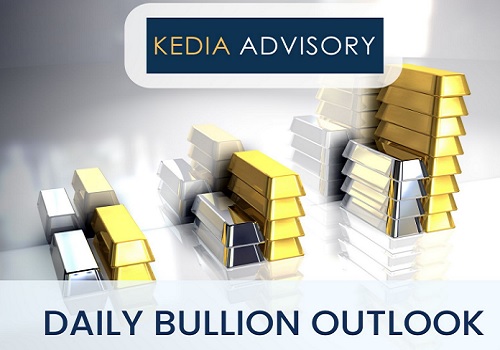Gold trading range for the day is 73165-74615 - Kedia Advisory

Gold
Gold prices rose by 0.82% to settle at ?74,040, driven by a weaker dollar, expectations of U.S. interest rate cuts, and ongoing tensions in the Middle East, which offset muted physical demand in key Asian markets. The Federal Reserve's projections indicated further cuts to the benchmark interest rate by the end of 2024, fueling positive sentiment for gold. Despite the global backdrop, demand in India and China, two of the largest gold consumers, remained subdued. In India, gold demand slightly improved but stayed well below normal levels as prices hovered near record highs. Indian dealers were offering discounts of up to $17 per ounce, down from $22 last week, while Chinese discounts widened to $12-$14 over global spot prices, compared to last week's $8.6-$10. Notably, Switzerland, a major bullion refining hub, saw no gold exports to China in August, marking the first time since January 2021. Swiss gold exports fell to their lowest level since June, although deliveries to India surged 38% month-on-month due to a sharp reduction in state gold import taxes, which are now at their lowest level in 11 years. Technically, the gold market is experiencing short covering, with a 0.39% drop in open interest, settling at 12,586 contracts. Gold prices increased by ?602, indicating strong upward momentum. Immediate support is seen at ?73,600, with further downside potential to ?73,165. On the upside, resistance is likely at ?74,325, and a break above this level could push prices towards ?74,615. The market remains sensitive to global economic and geopolitical developments.
Trading Ideas:
* Gold trading range for the day is 73165-74615.
* Gold prices rose amid expectations of more U.S. interest rate cuts and tensions in the Middle East
* Fed policymakers projected the interest rate would fall by another half of a percentage point by the end of this year.
* China refrained from gold imports from Switzerland in August, for the first time since January 2021
Silver
Silver settled up by 0.19% at ?90,135, supported by the Federal Reserve’s significant 50-basis-point rate cut in September, marking the start of its policy easing campaign. The Fed also indicated two more quarter-point cuts are likely before the year’s end, raising hopes for a soft landing of the U.S. economy as inflation returns to target. Despite this, Fed Chair Powell clarified that half-percentage-point cuts would not be the “new pace,” adding that the Fed is not in a rush to ease policy. Weaker sentiment in the U.S. dollar, partly driven by concerns that other central banks may not ease as aggressively as the Fed, also bolstered silver prices. Meanwhile, China kept its key lending rates unchanged, though markets still expect additional stimulus measures to support the economy following weak August economic data. In Europe, consumer confidence improved, with the Euro Area’s indicator rising to -12.9 in September 2024, the highest since February 2022, following the ECB’s rate cuts. India’s silver imports are set to nearly double this year, driven by strong demand from solar panel manufacturers and electronics makers, as well as investor interest in silver as a better investment than gold. India imported 4,554 tons of silver in the first half of 2024, up from 560 tons a year earlier. Technically, the market is under fresh buying, with open interest increasing by 0.07% to 25,086. Silver is supported at ?89,505, with a potential test of ?88,880. Resistance is now seen at ?90,750, and a move above this level could push prices to ?91,370.
Trading Ideas:
* Silver trading range for the day is 88880-91370.
* Silver gains following an outsized rate cut from the Federal Reserve.
* The US central bank kicked off its easing campaign with a large 50 basis point rate cut in September and signaled further rate reductions.
* China unexpectedly kept key lending rates unchanged this week even as the Fed’s aggressive rate cut provided room to ease policy.
Crude oil
Crude oil prices rose by 0.2% to settle at ?5,975, supported by rising tensions in the Middle East and tightening U.S. supply. An Israeli airstrike in southern Beirut, which killed top Hezbollah military figure Ibrahim Aqil, raised concerns over potential broader conflicts that could disrupt oil supplies. In addition, reports of U.S. refineries planning the lightest maintenance in three years suggest a potential boost in oil demand in the coming months. The Federal Reserve's larger-than-expected rate cut also contributed to expectations of increased economic activity and fuel consumption. On the supply side, crude oil production in the U.S. Gulf of Mexico gradually resumed after Hurricane Francine, with only 12% of production remaining offline compared to over 40% during the peak of the storm. However, global demand concerns persist, as the International Energy Agency (IEA) lowered its 2024 oil demand growth forecast to 900,000 barrels per day, driven by a slowdown in Chinese demand and higher adoption of electric vehicles. U.S. crude oil inventories fell by 1.63 million barrels in the week ending September 13, exceeding market expectations. Crude stocks at Cushing, Oklahoma, also dropped significantly by 1.979 million barrels. On the other hand, China’s crude imports in August fell 7% year-on-year due to weak refining margins and low fuel consumption, although shipments slightly rebounded from recent lows. Technically, crude oil is experiencing short covering, with open interest decreasing by 6.18%, settling at 12,965 contracts. Immediate support is seen at ?5,922, with a potential test of ?5,868. Resistance is likely at ?6,005, and a break above could push prices toward ?6,034.
Trading Ideas:
* Crudeoil trading range for the day is 5868-6034.
* Crudeoil prices ended with gains amid rising Middle East tensions and falling U.S. supply.
* US refineries are planning their lightest maintenance in three years, likely boosting oil demand in the coming months.
* A slowdown in Chinese demand as the main driver of weaker global demand growth.
Natural gas
Natural gas prices surged by 3.47% to ?202.7, supported by forecasts of warmer-than-usual weather, which is expected to drive up cooling demand and, consequently, gas consumption by power generators. This rise in prices came despite the U.S. Energy Information Administration (EIA) reporting a slightly higher-than-anticipated storage build last week, with U.S. utilities adding 58 billion cubic feet (Bcf) of gas into storage, above market expectations of 53 Bcf. This brought the total gas stockpiles to 3,445 Bcf, 194 Bcf higher than the same time last year, and 274 Bcf above the five-year average of 3,171 Bcf, keeping inventories within the historical range. LSEG forecasts suggest that average gas demand in the U.S. Lower 48 states, including exports, will slightly decrease from 99.6 billion cubic feet per day (bcfd) this week to 98.7 bcfd next week, while supply is expected to rise marginally from 101.8 bcfd to 101.9 bcfd. Notably, the EIA projects a decline in U.S. natural gas production in 2024 to 103.4 bcfd, down from a record 103.8 bcfd in 2023, as some producers reduce drilling activities. However, production is expected to rebound to 104.8 bcfd in 2025. On the consumption side, U.S. domestic gas usage is forecasted to hit a record 89.9 bcfd in 2024, reflecting a slight rise from 2023. From a technical standpoint, the market is experiencing short covering, with open interest dropping by 17.57% as prices climbed by ?6.8. Natural gas is currently finding support at ?195.4, with a potential test of ?188.1 if prices move lower. Resistance is likely at ?206.7, and a break above this level could push prices toward ?210.7, indicating sustained bullish momentum driven by supply-demand dynamics and weather forecasts.
Trading Ideas:
* Naturalgas trading range for the day is 188.1-210.7.
* Natural gas gains on warmer-than-normal weather forecasts that could boost cooling demand.
* That price increase came despite a slightly higher-than-expected weekly storage build.
* Average gas demand in the Lower 48, at 99.6 bcfd to 98.7 bcfd next week.
Copper
Copper prices declined by -0.61% to settle at ?809.45, driven by profit booking after recent gains from optimism around potential stimulus from China and a significant U.S. interest rate cut. The Federal Reserve initiated its monetary easing cycle with a larger-than-expected half-percentage point rate reduction, fueling hopes of increased global demand. Despite the pullback, copper was earlier supported by a drop in inventories, with Shanghai Futures Exchange warehouses reporting an 11.1% decline in copper stocks. On the supply side, China’s refined copper exports in August fell 56% from the previous month but remained 50% higher than the same period last year. China’s copper production also rose modestly by 0.9% year-on-year to 1.12 million metric tons in August. However, global copper market dynamics indicate an oversupply, with the International Copper Study Group (ICSG) reporting a 95,000 metric ton surplus in June, up from 63,000 metric tons in May. Meanwhile, unwrought copper imports into China dropped to a 16-month low in August, down 12.3% year-on-year, reflecting weaker domestic demand. On the other hand, copper concentrate imports rose by 3.2% in the first eight months of 2024 compared to the previous year. Technically, the copper market is experiencing long liquidation, with open interest dropping by 13.8%, settling at 5,197 contracts. Prices are finding immediate support at ?805.2, with a potential downside test at ?801. Resistance is expected at ?816.5, and a break above this level could push prices toward ?823.6. The market remains sensitive to global demand shifts and supply dynamics.
Trading Ideas:
* Copper trading range for the day is 801-823.6.
* Copper dropped on profit booking after seen supported on optimism about further stimulus from China.
* China exported 30,814 tons of refined copper in August, down 56% from the prior month.
* China's refined copper production in August rose 0.9% from the prior year to 1.12 million metric tons
Zinc
Zinc prices declined by 1.5%, settling at ?265.5, as inventories in warehouses monitored by the Shanghai Futures Exchange rose by 4.8%. Zinc ingot inventory reached 114,500 metric tons, with notable increases in the Shanghai and Guangdong regions due to imported ingots and weak downstream demand. Despite some need-based restocking, the overall demand remained subdued, contributing to the price decline. Customs data showed refined zinc imports for August 2024 at 26,500 metric tons, marking a 44.24% month-on-month increase but a 9.01% year-on-year decline. Cumulative imports from January to August totaled 267,000 metric tons, up 30.72% year-on-year. However, refined zinc exports for August were only 2,000 metric tons, resulting in net imports of 24,600 metric tons. On the supply side, the global zinc market surplus narrowed to 14,000 metric tons in July, down from 36,400 tons in June, according to the International Lead and Zinc Study Group (ILZSG). For the first seven months of 2024, the global surplus reached 254,000 tons, compared to 466,000 tons in the same period last year. China's refined zinc production in August fell by 0.68% month-on-month and 7.64% year-on-year due to power rationing, raw material procurement challenges, and maintenance shutdowns across various regions. Technically, the zinc market is undergoing long liquidation, with a substantial 25.91% drop in open interest, settling at 1,447 contracts. Prices fell by ?4.05, with immediate support at ?263.6, and further downside potential to ?261.5. Resistance is likely at ?269.4, and a break above this level could lead prices to test ?273.1. The market remains sensitive to supply disruptions and fluctuating inventories, especially in key regions like China.
Trading Ideas:
* Zinc trading range for the day is 261.5-273.1.
* Zinc dropped as SHFE inventories rose by 4.8% from last Friday.
* Refined zinc imports in August 2024 were 26,500 mt, up 8,200 mt or 44.24% MoM
* China unexpectedly leaving benchmark lending rates unchanged at the monthly fixing.
Aluminium
Aluminium prices fell by -2.09% to settle at ?226.9, as global primary aluminium output in August rose 1.2% year-on-year to 6.179 million tonnes, according to the International Aluminium Institute (IAI). China, the world’s largest aluminium producer, contributed 3.69 million tonnes to this total. Despite this production increase, China’s alumina exports fell 1.9% in August, with most of the supply directed to Russia. China's August aluminium output was the highest since 2002, reaching 3.73 million metric tons, a 2.5% increase year-on-year, driven by high prices and expectations of steady profits for smelters. A report from the World Bureau of Metal Statistics (WBMS) indicated a surplus in the global aluminium market, with a 127,900-ton surplus in July and a total surplus of 930,000 tons for the first seven months of 2024. Additionally, stocks at three major Japanese ports rose by 9.2% to 327,300 metric tons by the end of August, further highlighting an oversupply in the market. China’s aluminium producers, particularly in the southwestern Yunnan province, have been benefiting from abundant hydropower, enabling higher production levels. In the first eight months of 2024, China produced 28.91 million tonnes of aluminium, a 5.1% year-on-year increase. From a technical perspective, the aluminium market is under long liquidation, with open interest dropping by 28.28% as prices declined. Aluminium is finding support at ?224.8, and a break below this could test ?222.8. On the upside, resistance is now seen at ?230.6, and a move above that level could push prices to ?234.4. The market remains pressured by the rising global output and surplus.
Trading Ideas:
* Aluminium trading range for the day is 222.8-234.4.
* Aluminium dropped as global aluminium output rises 1.2% year on year in August
* China exported 143,268 tons of alumina last month, down 1.9% from a year earlier.
* China's Aug aluminium imports up 1.9% y/y.
Cottoncandy
Cottoncandy settled slightly up by 0.03% at ?58,430, following the USDA's reduction in India's cotton production forecast for the 2024-25 season to 30.72 million bales due to crop damage from excessive rains and pest issues. The reduction in ending stocks to 12.38 million bales also contributed to the market sentiment. Cotton acreage in the current kharif season is down by 9% at 110.49 lakh hectares compared to 121.24 lakh hectares in the same period last year, further limiting supply. However, the upside in prices was restrained by the arrival of raw cotton in Punjab's mandis. Cotton exports for the 2023-24 season, ending in September, are expected to rise by about 80% to 28 lakh bales, driven by strong demand from Bangladesh and Vietnam. In contrast, cotton exports in the previous season were only 15.50 lakh bales. Imports also saw an increase, rising to 16.40 lakh bales from 12.50 lakh bales last year. The Cotton Association of India (CAI) estimates that closing stocks by the end of September 2024 will drop to 23.32 lakh bales, down from 28.90 lakh bales a year earlier, due to high domestic consumption. On the global front, the U.S. cotton production forecast for 2024/25 was reduced to 14.5 million bales, and global production, consumption, and trade estimates were also lowered. World ending stocks are projected at 76.5 million bales. Technically, the market is under short covering, with open interest dropping by 1.96%. Cottoncandy has support at ?58,320, and a break below could see prices testing ?58,210. Resistance is likely at ?58,520, and a move above this level could push prices to ?58,610.
Trading Ideas:
* Cottoncandy trading range for the day is 58210-58610.
* Cotton gains as USDA has lowered India's cotton production forecast for the 2024-25 to 30.72 million bales
* Cotton exports for the 2023-24 crop year or season ending September are estimated at about 80 per cent at 28 lakh bales
* The U.S. cotton balance sheet for 2024/25 shows lower production, exports, and ending stocks compared to last month.
* In the global 2024/25 cotton balance sheet, beginning stocks, production and consumption are increased.
Turmeric
Turmeric prices rose by 1.71%, settling at ?14,414, driven by tighter supplies in the market and increased buying from stockists. Farmers are holding back stocks in anticipation of higher prices, adding to the upward momentum. However, the upside remains limited due to reports of increased sowing in key producing regions. In Indonesia, dry weather has accelerated harvesting, while in India, turmeric sowing has doubled along the Erode line, and in states like Maharashtra, Telangana, and Andhra Pradesh, sowing is estimated to be 30-35% higher than last year. This increase in acreage and low export demand may lead to further price corrections in the future. India's turmeric sowing for 2023-2024 is estimated at around 3.75-4 lakh hectares, up from 3-3.25 lakh hectares last year. Despite the higher acreage, turmeric production in 2024 is expected to reach 70-75 lakh bags, compared to 80-85 lakh bags in 2023. Export demand has also been weaker, with turmeric exports dropping by 19.52% in the April-June 2024 period compared to the same period in 2023. However, imports have surged significantly, rising by 485.40% during the same period. In the Nizamabad spot market, turmeric prices ended slightly lower at ?14,581.5, marking a marginal drop of 0.18%. Technically, the turmeric market is seeing short covering, with open interest falling by 0.73%, settling at 13,675 contracts. Immediate support is at ?14,128, with a potential test of ?13,844 on the downside. On the upside, resistance is likely at ?14,568, and a break above this level could push prices toward ?14,724. The market remains sensitive to changes in sowing and export dynamics.
Trading Ideas:
* Turmeric trading range for the day is 13844-14724.
* Turmeric gains amid tighter supplies in the market and emerging buying from stockists.
* Some support also seen as farmers are holding back stocks in anticipation of a further rise.
* However upside seen limited amid news of increased sowing.
* In Nizamabad, a major spot market, the price ended at 14581.5 Rupees dropped by -0.18 percent.
Jeera
Jeera prices rose by 0.96% to ?26,420, driven by robust domestic and export demand, alongside tight global supplies. Farmers are holding back their stocks in anticipation of better prices, further supporting the upward trend. However, the upside was limited due to expectations of higher production. The sowing area in Gujarat increased by 104%, and in Rajasthan by 16%, contributing to an anticipated 30% increase in jeera production this season, estimated at 8.5-9 lakh tonnes. Globally, jeera production has also seen a significant rise, with China’s output more than doubling to 55-60 thousand tons. Increased production in countries like Syria, Turkey, and Afghanistan is expected to further weigh on prices as new supplies enter the market. Turkey is projected to produce 12-15 thousand tons, while Afghanistan’s output could double, depending on weather conditions. The increased supply from these regions, along with reduced export trade, has pressured global cumin prices. India's domestic jeera production also saw a record output in Gujarat, estimated at 4.08 lakh tonnes, surpassing previous records. Despite this, analysts expect a surge in cumin exports, which could reach 14-15 thousand tonnes in February 2024, as international prices decline and India’s production grows. Technically, the market is under fresh buying, with open interest rising by 2.01% as prices gained ?250. Jeera is currently supported at ?26,230, with a potential test of ?26,040 if prices dip. On the upside, resistance is seen at ?26,550, and a move above this level could lead to prices testing ?26,680, signaling continued strong demand and supply constraints.
Trading Ideas:
* Jeera trading range for the day is 26040-26680.
* Jeera gains amid robust domestic and export demand besides tight global supplies.
* Farmers holding back their stocks on expectation of better prices too bolstered prices.
* Turkey anticipates producing 12-15 thousand tons, while Afghanistan's output could double.
* In Unjha, a major spot market, the price ended at 26054.65 Rupees dropped by -0.13 percent.
Views express by all participants are for information & academic purpose only. Kindly read disclaimer before referring below views











